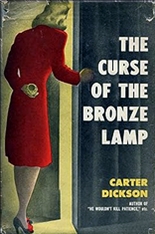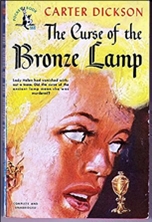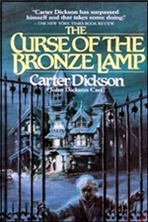Thu 31 Aug 2023
by Robert E. Briney
CARTER DICKSON – The Curse of the Bronze Lamp. Morrow, hardcover, 1945. Paperback editions include: Pocket 568, 1949. Berkley, 1967. Carroll & Graf, 1984.

When it became clear that John Dickson Carr’s output of mystery novels — seven novels in less than four years — was more than his original publisher could handle, some of the books were diverted to a second publisher, to be issued under a pen name.
The first of these pseudonymous works, The Bowstring Murders ( 1933), carried the by-line Carr Dickson. This was a publisher’s error and was quickly corrected to the scarcely less obvious Carter Dickson. Dickson’s series detective, Sir Henry Merrivale (“H. M.”), was introduced in The Plague Court Murders in 1934.
Like Carr’s Dr. Gideon Fell, H.M. is fat, funny, and formidably intelligent. His appearance and mannerisms arc more reminiscent of Churchill than of Chesterton, who was the model for Gideon Fell. H.M. is more overtly comic: a large, bald, vulgar, and frequently childish figure, fond of practical jokes, continually outraged at the twist of fate that put him in the House of Lords, and full of insults for the government bureaucrats with whom he must deal in his somewhat mysterious capacity as “that astute and garrulous lump who sits with his feet on the desk at the War Office.”

Almost all of the H.M. stories involve locked rooms or impossible crimes. The centerpieces in The Curse of the Bronze Lamp are a pair of vanishings as startling as any produced by stage illusionists. Helen Loring, daughter of British archaeologist Lord Severn, has been presented by the Egyptian government with a bronze lamp taken from a Twentieth Dynasty tomb.
An Egyptian fortune-teller, Alim Bey, claims that the lamp carries a curse, and that Helen will be “blown to dust as if she had never existed” if she takes the lamp out of Egypt. Helen returns to England with the lamp, having announced her intention to disprove the curse. Arriving at Severn Hall with friends, Helen gets out of the car and runs ahead of them into the entrance hallway. A few moments later, her raincoat and the bronze lamp are found lying in the middle of the hall floor, and Helen has vanished without a trace.

Shortly thereafter, Lord Severn arrives from Egypt and disappears from his study in the same fashion, leaving behind his outer clothing-and the bronze lamp. H.M., whom Helen had asked for advice in Egypt (where his encounter with an Arab taxi driver provided a memorable interlude of slapstick humor), is drawn into the case.
Romantic entanglements, stolen antiquities, the activities of H.M.’s Scotland Yard nemesis, Inspector Humphrey Masters, and the continuing doom-filled prophecies of Alim Bey supply only part of the smoke screen through which H.M. must find his way, which of course he does in satisfactory fashion.
As always in Carr/Dickson, the clues prove, in retrospect, to have been fairly planted, but it is a rare reader who can recognize them and put all the pieces together ahead of the detective.
———
Reprinted with permission from 1001 Midnights, edited by Bill Pronzini & Marcia Muller and published by The Battered Silicon Dispatch Box, 2007. Copyright © 1986, 2007 by the Pronzini-Muller Family Trust.
August 31st, 2023 at 9:40 pm
I have on occasion gotten to the killer before Christie or Sayers only from a knowledge of their methods and idiosyncrasies, I don’t think I ever got that far ahead of Carr, well, perhaps only in CAPTAIN CUT-THROAT where knowing Carr’s audacity there can only be one killer.
September 1st, 2023 at 2:48 pm
I’ve never had much luck outguessing Carr, as many times as I’ve tried. I’ve had somewhat better success with Christie’s plots, but only marginally. Threw the book across the room after finishing ORIENT EXPRESS.
September 1st, 2023 at 9:47 pm
For all its popularity ORIENT EXPRESS ends up not working that well as a fair play detective story (Fair Play?!) but does surprisingly work as a character study, particularly of Poirot, and a sort of morality play.
It goes to a personal thesis that Christie was as much or more interested in the moral impact of murder as the detective element or the ends of justice, something I think is clearest in the Quin stories.
Otherwise, I tend to agree with Chandler regarding the solution.
September 2nd, 2023 at 10:02 am
From one of the better studies of Christie and her stories online, http://www.editoreric.com/greatlit/authors/Christie.html :
“Raymond Chandler had Christie and her English colleagues in mind when he wrote his devastating critique of their entertainments in his essay “The Simple Art of Murder”:
“‘There is a very simple statement to be made about all these stories: they do not really come off intellectually as problems, and they do not come off artistically as fiction. They are too contrived, and too little aware of what goes on in the world.’
“He picked Christie’s best-known Hercule Poirot mystery, Murder on the Orient Express (1934), as one example of a particularly implausible bit of detection with a solution “only a halfwit could guess”. Of course, that didn’t keep it from becoming one of the most popular of all mystery novels and the basis for continually popular films.”